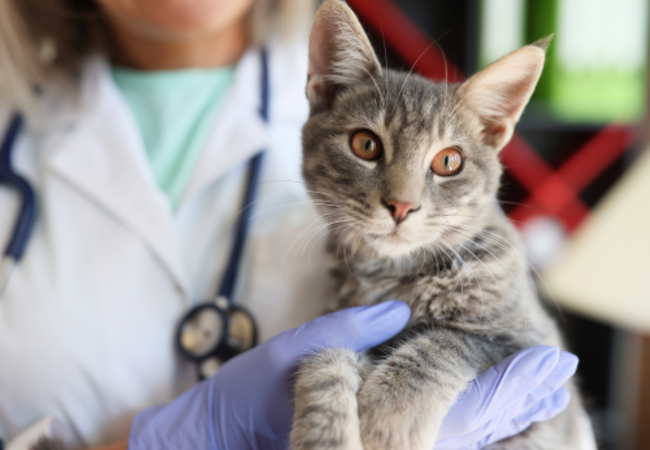Cat Chemotherapy 2025: Veterinary Guide 🩺🐾

In this article
Cat Chemotherapy 2025: Veterinary Guide 🩺🐾
By Dr. Duncan Houston BVSc
Hello! I’m Dr Duncan Houston BVSc, veterinarian and founder of Ask A Vet. If your feline companion has received a cancer diagnosis—such as lymphoma, mast cell tumors, or carcinoma—you may be considering chemotherapy. In 2025, veterinary oncology offers refined, gentle protocols designed to shrink tumors, slow disease progression, and maintain quality of life. In this in-depth guide, we'll explore when to use chemo, how it's administered, common medications, potential side effects, costs, and supportive care at home. Plus, discover how tools like Ask A Vet, can enhance feline comfort and treatment success. 🐱💙
1. When Is Chemotherapy Recommended? 🎯
- Lymphoma: the most common cat cancer—chemo is often first-line therapy.
- After surgery, to destroy microscopic disease in aggressive cancers like mast cell tumors, soft-tissue sarcomas, or carcinomas.
- Non‑surgical tumors, such as gastrointestinal carcinoma or lymphoma) to slow disease spread and improve comfort.
In cats, unlike many human treatments, the goal is to improve **quality of life**, not necessarily cure disease—a gentler, tailored approach prioritizes comfort.
2. How Is Chemotherapy Administered? 💉
Veterinary oncologists use a variety of methods:
- Intravenous (IV): placed via catheter in leg or neck.
- Subcutaneous (SQ), intramuscular (IM), intralesional or oral: depending on drug and protocol.
Typical day: fasting for ~8 hours prior; physical exam, bloodwork (CBC, chemistry), catheter placement, chemo administration, followed by anti-nausea and supportive meds.
3. Common Drugs & Protocols 🧪
- Lymphoma (high-grade): multi-agent protocols—vincristine, cyclophosphamide, doxorubicin + prednisone.
- Low-grade (small-cell lymphoma): chlorambucil + prednisolone, often oral at home.
Newer approaches like metronomic chemotherapy deliver low-dose chemo daily to inhibit tumor blood supply, minimizing side effects.
4. What Side Effects Can Occur? 🩹
Cats tolerate chemotherapy much better than humans. Most experience mild or no side effects if managed properly.
- Mild GI upset: occasional vomiting, mild diarrhea, decreased appetite—usually 3–5 days post-treatment.
- Bone marrow suppression: neutrophil or platelet drops—<10-20% of cats need delay or supportive care.
- Low white cells: raises infection risk; CBC monitoring is critical.
- Rare alopecia: cats don’t typically lose coat hair—whisker loss is possible.
- Organ effects: rare medication-specific toxicity—oncologists monitor kidney, liver function via labs.
Severe side effects or low quality of life prompt immediate treatment modification or discontinuation.
5. Monitoring & Long–Term Care 📝
- Regular exams & bloodwork before each session—especially CBC ~5–7 days post-chemo.
- Assess tumor response by size, cat’s energy, and appetite.
- Adjust dosage/schedule based on response and side effects.
6. Prognosis by Cancer Type 🩺
- High‑grade lymphoma: ~50–75% achieve meaningful response; ~25% achieve remission. Survival ~6–9 months, with ~1/3 living ≥2 years.
- Low‑grade lymphoma: ~70–90% remission; many manage as a chronic condition with maintenance therapy; median survival 1.5–3 years.
- For other cancers, outcomes vary; chemo helps control the spread and improve comfort.
7. Cost Considerations 💵
Each chemical infusion or oral treatment may run ~$150–600 per session; total varies with protocol length.
- Additional costs: diagnostics, bloodwork, supportive meds, vet visits, travel.
- Insurance may cover 70‑90%—check specifics on deductions, maximums.
8. Home Care & Wellness Support 🏡
- Prescribe anti-nausea meds; feed small, palatable meals on chemo days.
- Rest in quiet spaces; no strenuous play after infusion.
- Monitor appetite, vomiting, stool, energy, nosebleeds, tremors; log symptoms.
- Maintain hydration, hygiene, and gentle grooming.
9. Tools: Ask A Vet💡
- Ask A Vet: Telehealth follow-ups, side effect management, medication guidance, travel advice.
10. When to Seek Immediate Help 🚨
- Persistent vomiting/diarrhea >24 hrs or refusing food/water.
- Fever (>39.6 °C), pale gums, lethargy, or breathing trouble.
- Neurologic signs: tremors, weakness, seizures.
- Severe side effects—contact your vet or emergency clinic immediately.
11. Final Thoughts 📝
In 2025, cat chemotherapy is a carefully balanced approach: **treating cancer while preserving your cat’s comfort and joy**. With veterinarian-guided protocols—fewer side effects, thoughtful monitoring—and supportive tools like Ask A Vet, Woopf, and Purrz, many cats enjoy extended, quality lives. Every treatment plan is individualized, ensuring therapy aligns with both medical goals and your cat’s well-being. 🐾💙
Considering chemotherapy? Start with a telehealth consultation at AskAVet.com, explore supportive diet & hydration options through Together, we’ll support your feline friend every step of the way. 🌟


